Daily Current Affairs for UPSC 29th Oct 2025



| Index |
| S.No | Topic | Page No |
| Daily Hindu Analysis |
| 1. | Setting up an early warning system for the Himalayas poses unique challenges |
|
| 2. | A quip that stings but also inspires |
|
| 3. | IIP growth dips to three-month low of 4% in Sept. | |
| 4. | Centre approves terms of 8th Central Pay Commission | |
| 5. | Cloud-seeding trials held to check drop in air quality |
|
| 6. | Union Cabinet decides to raise fertilizer subsidy for winter crops to ₹37,952 crore |
|
| 7. | How Amazon’s cloud outage affected services and apps globally | |
| Daily Current Affairs |
| 8. | Jiyo Parsi Scheme |
|
| 9. | Prevention of Money Laundering Act (PMLA), 2002 – Strengthened Enforcement by ED” |
|
| 10. | Global Gender Gap Report 2024 |
|
| 11. | Nagaland University Study Sounds Environmental Alert for Loktak Lake | |
Setting up an early warning system for the Himalayas poses unique challenges
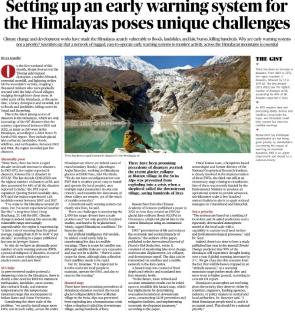
Syllabus: GS Paper 3 – Disaster Management, Environment, Climate Change, and Science & Technology Applications
Context
- The recent rise in Himalayan disasters — including flash floods, landslides, glacial lake outbursts (GLOFs), and earthquakes — has highlighted the urgent need for Early Warning Systems (EWS).
A 2024 Down To Earth (DTE) report noted that between 1902–1962, the region recorded just five disasters, but between 2013–2022, it reported 68 major events — accounting for 44% of all disasters in India during that period. - However, despite the alarming frequency, India still lacks a robust, networked, and rugged EWS architecture tailored for the Himalayan terrain. Scientists argue that developing such a system is crucial to prevent catastrophic loss of life in climate-vulnerable mountain ecosystems.
What the Issue is About Climate Change and Development Pressure - The Himalayas, known as the “Third Pole” for their vast ice reserves, are warming twice as fast as the global average.
- This warming triggers:
- Glacial melting → GLOFs (Glacial Lake Outburst Floods)
- Erratic precipitation → flash floods & landslides
- Permafrost thawing → slope instability & infrastructure collapse
- Unregulated development — roads, hydropower, tourism — amplifies vulnerability.
Recent Disasters - The Mount Everest blizzard (Oct 2025) trapped thousands of trekkers.
- Sikkim flash floods (2023) and Chamoli tragedy (2021) highlighted the destructive potential of GLOFs.
- These incidents show how early detection and warnings could have saved lives.
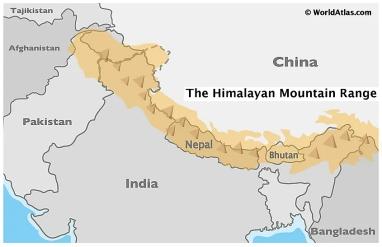
What is an Early Warning System (EWS)?
An Early Warning System is an integrated framework that uses real-time monitoring, data analysis, and alert mechanisms to predict and communicate the likelihood of a natural disaster, enabling early action. Key Components of EWS
- Risk Knowledge – Mapping hazard zones and vulnerable populations.
- Monitoring and Forecasting – Using sensors, satellites, and local stations to collect and analyze data.
- Dissemination – Communicating timely alerts to authorities and communities.
- Response Capability – Ensuring people and agencies know how to act upon warnings.
Analysis 1. Rising Frequency of Himalayan Disasters
- According to Down To Earth, disasters in the Himalayas have quadrupled in the last 50 years.
- NASA’s landslide database shows 1,211 landslides in the region between 2004–2017.
- Increasing glacial retreat, rainfall extremes, and infrastructure stress have pushed mountain communities into a perpetual state of risk.
2. Why Setting Up EWS is Difficult in the Himalayas | Challenge | Explanation |
| Rugged Terrain | Remote, steep, and inaccessible areas make it hard to install and maintain sensors. |
| Fragmented Data Systems | Lack of integrated regional databases across states and institutions. |
| Limited Local Capacity | Shortage of trained personnel and weak coordination between agencies. |
| Poor Communication Networks | Weak connectivity prevents real-time data transmission or alerts. |
| Climatic Complexity | Microclimates vary drastically — one valley can flood while another stays dry. |
| Lack of Prioritization | Disaster management focuses on post-event relief, not anticipatory measures. |
3. Lessons from Global Models - Switzerland:
- After a glacier collapse in the Swiss Alps, early sensors detected the event, saving hundreds downstream.
- The system combined seismic sensors, radar monitoring, and AI prediction models.
- China:
- In 2022, the Chinese Academy of Sciences developed an EWS for GLOFs in the Tibet–Himalaya region, combining satellite data and AI-based models.
These cases demonstrate that EWS can drastically reduce casualties when integrated into local planning and supported by robust communication channels.
4. Indian Scenario and Emerging Efforts
- The National Geophysical Research Institute (NGRI) and IIT Roorkee have begun research on low-cost, rugged monitoring devices for Himalayan slopes.
- A new multi-hazard monitoring initiative funded by the Ministry of Environment and Climate Change aims to install 100+ early-warning nodes across Uttarakhand and Himachal Pradesh.
- However, progress remains fragmented and lacks policy-level prioritization and dedicated funding.
5. The Way Forward | Policy Focus | Strategic Actions Needed |
| Institutional Integration | Create a unified Himalayan Disaster Management Grid linking IMD, NDMA, and ISRO. |
| Technological Investment | Deploy low-cost, solar-powered sensors and satellite-linked alert systems. |
| Community-Centric Design | Train local panchayats and mountain communities in early warning response. |
| Cross-Border Cooperation | Collaborate with Nepal, Bhutan, and China on transboundary hazard monitoring. |
| Policy Prioritization | Recognize EWS in the Himalayas as a national security and climate resilience priority. |
UPSC Mains Q.
“In the era of accelerating climate change, the absence of an integrated early warning system makes the Himalayas a hotspot of preventable disasters.” Discuss the challenges and the way forward in establishing an effective early warning network in the Himalayan region.
A quip that stings but also inspires
GS Paper 3 – Economy (Growth, Development, and Economic History) Context
- The 2025 Nobel Prize in Economics sparked wide debate after laureate Joel Mokyr remarked that “economic historians don’t win the prize.”
- This tongue-in-cheek observation ignited discussions on the role of history in understanding economics, the value of long-term analysis, and the relationship between technology, society, and growth.
- While Mokyr’s remark stung economic historians, it also served as an intellectual provocation — highlighting that modern economic policy debates often ignore historical context, focusing instead on short-term empirical correlations and quantitative models.
What the Article is About - The intellectual significance of Mokyr’s Nobel and his central argument that modern growth is a social technology—built on collective learning, civic institutions, and historical experimentation.
- How economic history continues to matter in understanding today’s transitions — from artificial intelligence (AI) to digital capitalism.
- The tension between “history as insight” and “economics as measurement” in shaping modern policymaking and innovation studies.
Detailed Analysis 1. The Central Thesis: Growth as a Social Technology
- Mokyr’s argument, rooted in his earlier works such as The Enlightened Economy and A Culture of Growth, views technological progress as a collective social phenomenon, not merely the outcome of isolated inventions.
- The Industrial Enlightenment fostered a culture of shared learning, guild-based skill networks, and open knowledge diffusion — much like today’s innovation clusters or start-up ecosystems.
- In this framework, innovation is cumulative and civic, driven by institutions that reward learning, collaboration, and dissent — not merely by markets or profit motives.
2. History vs. Measurement: The Nobel Debate - Mokyr’s quip that “economic historians don’t win Nobel Prizes” reflects a disciplinary bias — modern economics tends to privilege regression-based models over archival, interpretive evidence.
- Yet, historical economics offers crucial insights:
- How technological systems evolve through trial and error.
- How societal structures like guilds, apprenticeships, and public institutions shaped innovation.
- Why past economic shocks (wars, pandemics, depressions) inform today’s policy choices.
3. Current Resonance: Technology, AI, and Labor Transitions - The world stands at a new inflection point — AI replacing cognitive labor parallels the Industrial Revolution’s replacement of manual labor.
- The Aghion-Howitt “Schumpeterian” growth framework—emphasizing creative destruction—is evolving again, this time around algorithmic innovation and digital labor displacement.
- Mokyr’s framework helps analyze these transitions beyond the hype of disruption, focusing on how societies adapt, retrain, and reallocate resources in response to technological shocks.
4. Inequality and the Politics of Knowledge - Historical economic study reveals how technological diffusion and access determine inequality more than innovation itself.
- Just as the printing press, coffee houses, and pamphleteering once democratized knowledge, today’s digital technologies face “access barriers” and algorithmic monopolies that reinforce privilege.
- The lesson: Technology’s promise is social, but its ownership and governance shape outcomes.
- Mokyr’s work thus warns against narrow techno-optimism, arguing for public investment in education, open science, and digital commons.
5. The Continuing Relevance of Economic History - Mokyr’s Nobel brings economic history back to the center of economic thought — a reminder that:
- Policy needs perspective: Inflation, productivity, or labor reform debates require long-run framing.
- Data needs context: Numbers without narratives risk misreading structural change.
- Economics needs humility: Progress depends as much on social learning as on market efficiency.
In short, economic history acts as a vaccine against both euphoria and despair — grounding innovation policy in realism.
UPSC Mains Q. “Economic history is not merely a record of the past, but a lens to understand technological and institutional evolution.”
Discuss this statement in the context of Joel Mokyr’s contributions to the economics of growth and innovation.
IIP growth dips to three-month low of 4% in Sept.

GS Paper: GS Paper 3 – Indian Economy (Growth, Development, and Industrial Sector)
Context India’s industrial activity slowed down in September 2025, with the Index of Industrial Production (IIP) growth dipping to a three-month low of 4%, as per the latest data released by the Ministry of Statistics and Programme Implementation (MoSPI). This moderation comes after a brief recovery in July 2025 (4.3% growth), and highlights persistent weakness in manufacturing output, mining, and electricity generation. Furthermore, IIP growth for the April–September 2025 period stood at just 3%, marking the slowest first-half growth in at least five years — indicating concerns about industrial momentum and domestic demand amid global headwinds.
What is the Index of Industrial Production (IIP)?
Definition:
- The Index of Industrial Production (IIP) is a composite indicator that measures the short-term changes in the volume of production in a country’s industrial sector.
- It is a key economic indicator reflecting the level of industrial activity and the health of the manufacturing sector, which contributes about 17–18% of India’s GDP.
Compiled By: National Statistical Office (NSO), under the Ministry of Statistics and Programme Implementation (MoSPI).
Base Year: Currently 2011–12 (with plans under consideration to revise it to 2017–18).
Sectors Covered: The IIP measures output in three major sectors: | Sector | Weight in IIP | Description |
| Manufacturing | 77.6% | Includes 23 industry groups like food, textiles, chemicals, machinery, etc. |
| Electricity | 7.99% | Measures power generation and supply output. |
| Mining | 14.37% | Includes coal, crude oil, and other mineral extraction. |
Use-Based Classification: IIP is also classified by use-based categories, which provide insights into demand trends:
- Primary Goods
- Capital Goods (investment indicator)
- Intermediate Goods
- Infrastructure/Construction Goods
- Consumer Durables
- Consumer Non-Durables
Current Data Highlights (September 2025) - Overall IIP Growth: 4% (lowest in 3 months)
- April–September 2025 Growth: 3% — slowest in at least 5 years
Analysis 1. Sluggish Manufacturing Sector - Manufacturing, which forms over three-fourths of the IIP, remains subdued due to weak consumer demand, higher borrowing costs, and global trade uncertainties.
- Sectors like textiles, metals, and chemicals showed contraction, while automobiles and electronics provided limited positive momentum.
2. Low Capital Goods Growth - The capital goods index, often viewed as a proxy for private investment, has stagnated — indicating weak capacity expansion by industries.
- This signals cautious investor sentiment despite government emphasis on ‘Make in India’ and ‘PLI schemes’.
3. Energy and Mining Output - Mining activity was dampened by monsoon-related disruptions, while electricity output remained stable but did not expand enough to offset declines in manufacturing.
4. Demand-Side Weakness - Consumer durables (like electronics, white goods) saw weak demand, reflecting cautious household spending amid inflation and high EMIs.
- Consumer non-durables, like FMCG products, grew moderately — suggesting rural consumption remains tepid.
6. Comparison with Other Indicators | Indicator | Recent Trend |
| PMI (Manufacturing) | Steady but moderating (~55 in Sept 2025). |
| Core Sector Growth | Slowed to ~5% in Sept. |
| CPI Inflation | Moderating but above RBI’s comfort band (~4.8%). |
| Exports | Contracted due to global slowdown. |
UPSC Prelims Q. Consider the following statements about the
Index of Industrial Production (IIP):
- It is released monthly by the Reserve Bank of India.
- Manufacturing has the highest weight in the IIP.
- The base year for calculating IIP is 2011–12.
Which of the above statements is/are correct?
(a) 1 and 2 only
(b) 2 and 3 only
(c) 1 and 3 only
(d) 1, 2 and 3
Answer: (b) 2 and 3 only
Centre approves terms of 8th Central Pay Commission 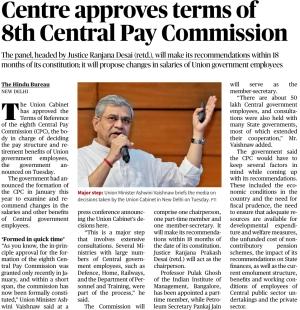
Syllabus Mapping: GS2 – Governance (Government Policies and Interventions)
GS3 – Economy (Government Budgeting, Public Expenditure, Fiscal Policy)
Context The Union Cabinet has approved the Terms of Reference (ToR) for the 8th Central Pay Commission (CPC), which is responsible for recommending revisions in salary structures, allowances, and retirement benefits of Union government employees and pensioners. The Commission, chaired by Justice Ranjana Prakash Desai (Retd.), has been mandated to submit its recommendations within 18 months. This move impacts nearly 50 lakh Central government employees and pensioners, making it a significant administrative and fiscal development.
What is the Central Pay Commission?
The Central Pay Commission (CPC) is an extra constitutional body (set up by the Union Government through executive resolution, not under the Constitution) that reviews and recommends changes to the salary structure of Central government employees, including:
- Civil servants
- Defence personnel
- Employees of Central Public Sector Undertakings (CPSUs)
- Pensioners
Objective: To ensure parity between inflation, cost of living, and government remuneration, while maintaining fiscal sustainability. About the 8th Central Pay Commission
Composition:
- Chairperson: Justice Ranjana Prakash Desai (Retd.)
- Member (Part-time): Prof. Pulak Ghosh, IIM Bangalore
- Member-Secretary: Pankaj Jain, IAS (Secretary, Department of Expenditure)
Mandate / Terms of Reference: - Review and recommend changes in pay structure, allowances, and pension benefits.
- Examine economic and fiscal conditions to ensure financial prudence.
- Suggest reforms in non-contributory pension schemes.
- Assess impact on State finances, and propose coordination between Centre and States.
- Ensure that pay parity and welfare measures are in line with employee productivity and public service standards.
Analysis 1. Administrative Significance:
- The CPC ensures periodic review of pay structures, preventing stagnation in government service.
- It helps maintain morale, efficiency, and retention within public administration, particularly among defence and technical cadres.
2. Economic Implications: - Positive:
- Boosts domestic consumption and demand, especially in middle-income households.
- Indirectly contributes to GDP growth via increased spending.
- Concerns:
- The 7th CPC (2016) increased salaries by ~23.5%, contributing to fiscal stress.
- The 8th CPC must balance between employee welfare and macroeconomic stability, especially amid fiscal deficit concerns.
- Large pay hikes may crowd out spending on developmental and capital expenditure.
3. Fiscal Prudence Challenges: - The Commission must ensure that wage revisions do not destabilize the Fiscal Responsibility and Budget Management (FRBM) targets.
- It must align pay hikes with inflation, productivity, and resource availability.
- The inclusion of non-contributory pension liabilities further adds to fiscal strain.
4. Broader Governance Perspective: - Regular pay revisions improve governance efficiency and accountability, ensuring that employees remain motivated.
- However, frequent pay hikes without productivity assessment risk creating a costly bureaucracy with limited efficiency gains.
UPSC Prelims Q. Consider the following statements regarding the Central Pay Commission (CPC):
- The Central Pay Commission is a constitutional body established under Article 309 of the Constitution.
- Its recommendations are binding on the Union Government.
- The 8th Central Pay Commission will make its recommendations within 18 months of its constitution.
Which of the above statements is/are correct? (a) 1 and 2 only
(b) 2 and 3 only
(c) 3 only
(d) 1 and 3 only
Answer: (c) 3 only
Cloud-seeding trials held to check drop in air quality
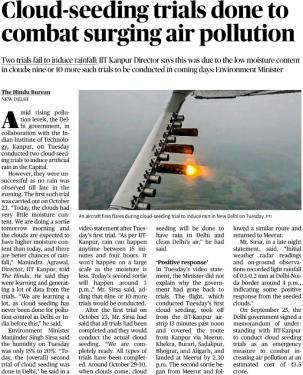
Syllabus Mapping: GS Paper 3 – Environment (Pollution, Climate Engineering, and Technology in Environment Management)
Context
- With Delhi’s air quality worsening amid surging pollution levels, the Delhi government, in collaboration with the Indian Institute of Technology (IIT) Kanpur, has begun cloud-seeding trials to induce artificial rainfall.
- Two cloud-seeding operations were conducted recently (on October 23 and 28, 2025), but no significant rainfall was observed due to low moisture content in clouds. Despite these initial setbacks, officials plan 9–10 more trials in the coming days, hoping for improved results as atmospheric conditions change.
- The aim is to artificially trigger rainfall that can help wash away pollutants, reduce Particulate Matter (PM2.5 and PM10) concentrations, and temporarily improve Delhi’s Air Quality Index (AQI).
What is Cloud Seeding? Cloud Seeding is a form of weather modification technology designed to enhance precipitation (rain or snow) by dispersing certain substances into the atmosphere that encourage cloud condensation and droplet formation.
Common Chemicals Used:
- Silver Iodide (AgI)
- Potassium Iodide (KI)
- Sodium Chloride (NaCl – common salt)
- Dry Ice (Solid CO₂)
These chemicals act as cloud condensation nuclei (CCN) — tiny particles that provide a surface for moisture in clouds to condense upon, forming larger droplets that eventually fall as rain.
Process of Cloud Seeding: - Identification of Suitable Clouds:
Meteorologists identify clouds with sufficient moisture and updraft potential. - Aerial or Ground-Based Seeding:
Aircraft or rockets disperse the seeding agents into the clouds. - Microphysical Reaction:
Particles catalyze the formation of larger droplets. - Precipitation:
When droplets reach a critical size and weight, they fall as rain.
Analysis 1. Purpose of the Current Operation
- Delhi’s air quality has plunged to the ‘severe’ category, mainly due to stubble burning, vehicle emissions, and winter inversion that traps pollutants near the surface.
- Artificial rain through cloud seeding is being attempted as an emergency measure to temporarily reduce pollution levels by settling dust and particles.
- The initiative is part of a ₹3.2 crore MoU between IIT Kanpur and the Delhi Government signed on September 25, 2025.
2. Challenges Observed - Low moisture content in clouds over Delhi and adjoining areas hindered rainfall formation.
- Humidity levels were between 15–20%, well below the ideal threshold of 40–50% needed for effective cloud seeding.
- IIT Kanpur’s Director Manindra Agrawal stated that while the trials generated valuable data, rainfall cannot be guaranteed even under controlled conditions.
3. Potential Benefits - Pollution Mitigation: Artificial rain helps remove particulate matter from the air, improving visibility and health outcomes.
- Water Resource Management: Can be used to enhance rainfall in drought-prone or arid regions.
- Agricultural Benefits: Helps maintain soil moisture and crop yields during dry spells.
4. Limitations and Concerns | Limitation | Explanation |
| Dependence on Weather Conditions | Requires pre-existing clouds with adequate moisture; cannot create clouds on its own. |
| Short-Term Relief | Offers temporary pollution control; does not address root causes of emissions. |
| Environmental Concerns | Chemicals like silver iodide may accumulate in ecosystems over time. |
| High Costs and Uncertain Success Rate | Effectiveness varies (30–50% success rate globally). |
| Ethical and Geopolitical Issues | Large-scale weather modification could impact neighboring regions’ rainfall patterns. |
6. Scientific Perspective Meteorologists emphasize that cloud seeding cannot replace long-term pollution control policies such as:
- Reducing vehicular emissions,
- Controlling industrial discharge, and
- Managing stubble burning effectively.
However, as an emergency measure, it can offer short-term atmospheric relief in heavily polluted environments.
UPSC Prelims Q. With reference to Cloud Seeding, consider the following statements:
- Cloud seeding involves dispersing substances like silver iodide or sodium chloride into clouds to induce rainfall.
- Cloud seeding can create clouds in completely dry conditions.
- India has conducted cloud seeding trials in cities like Delhi and Pune.
Which of the above statements is/are correct?
(a) 1 and 3 only
(b) 2 only
(c) 1 and 2 only
(d) 1, 2 and 3
Answer: (a) 1 and 3 only
Union Cabinet decides to raise fertilizer subsidy for winter crops to ₹37,952 crore
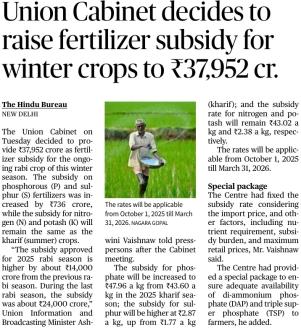
Syllabus Mapping: - GS Paper 3 – Agriculture: Subsidies, Pricing and Food Security
- GS Paper 2 – Governance: Government Policies and Interventions
Context The Union Cabinet has approved a ₹37,952 crore fertilizer subsidy for the Rabi (winter) crops of 2025–26, representing a significant increase of around ₹14,000 crore from the previous Rabi season’s subsidy of ₹24,000 crore. This enhanced subsidy aims to stabilize fertilizer prices, support farmers, and ensure adequate availability of key nutrients such as Nitrogen (N), Phosphorous (P), Potash (K), and Sulphur (S) during the upcoming Rabi cropping season. The revised subsidy rates will be applicable from October 1, 2025 to March 31, 2026.
What is a Fertilizer Subsidy?
A fertilizer subsidy is the financial support provided by the government to fertilizer manufacturers or importers so that fertilizers can be sold to farmers at a price lower than the market rate. This ensures that farmers can afford essential plant nutrients and maintain agricultural productivity.
Objective:
- To make fertilizers affordable for farmers.
- To encourage balanced use of nutrients (N, P, K, S).
- To protect farmers from global price volatility in fertilizer markets.
- To support food security by sustaining crop yields.
Types of Fertilizer Subsidy in India | Scheme | Description |
| Nutrient-Based Subsidy (NBS) Scheme | Introduced in 2010, provides fixed subsidy per kg of nutrient (N, P, K, S) content in fertilizers like DAP, MOP, TSP, etc. |
| Urea Subsidy | Controlled under the Retention Pricing Scheme (RPS) – urea prices are fixed and the government bears the difference between the cost of production and sale price. |
| Direct Benefit Transfer (DBT) | Since 2018, subsidy is transferred to fertilizer companies after sale to farmers is recorded through the point-of-sale device using Aadhaar authentication. |
Key Highlights of the 2025 Rabi Subsidy Decision - Total allocation: ₹37,952 crore
- Increase: ₹14,000 crore more than the last Rabi season.
- Period: October 1, 2025 – March 31, 2026
- Subsidy increase:
- Phosphate (P): ₹47.96/kg (up from ₹43.60/kg)
- Sulphur (S): ₹2.87/kg (up from ₹1.77/kg)
- Nitrogen (N): ₹43.02/kg (unchanged)
- Potash (K): ₹2.38/kg (unchanged)
Union Minister Ashwini Vaishnaw stated that the subsidy rate was fixed based on import prices, nutrient requirements, and maximum retail prices to protect farmers from input cost inflation.
Analysis 1. Importance for Farmers and Food Security - The increase in subsidy will shield farmers from rising global fertilizer prices and ensure affordable access to key inputs during the crucial Rabi season.
- It supports production of key winter crops like wheat, mustard, and pulses, which are essential for India’s food security.
2. Fiscal Implications - Fertilizer subsidy forms one of the largest components of India’s subsidy bill, alongside food and fuel.
- The allocation for FY 2025–26 is expected to push the total fertilizer subsidy expenditure beyond ₹2 lakh crore, exerting pressure on fiscal deficit targets.
3. Global Context - India imports over 80% of its phosphatic and potassic fertilizers.
- The Russia–Ukraine war, energy price hikes, and disrupted global supply chains have increased fertilizer import costs significantly.
4. Nutrient Balance Concern - Excessive use of urea (nitrogen-based fertilizer) due to its low price has led to soil nutrient imbalance.
- The government is trying to promote balanced fertilization through the Nutrient-Based Subsidy Scheme and the introduction of Nano Urea.
5. Environmental Dimension - Subsidy rationalization and balanced nutrient use are key for improving soil health and reducing greenhouse gas emissions from overuse of nitrogen fertilizers.
UPSC Prelims Q. With reference to India’s fertilizer subsidy policy, consider the following statements:
- Under the Nutrient-Based Subsidy (NBS) Scheme, the subsidy is provided directly to farmers through the DBT system.
- The price of urea in India is statutorily controlled, and the government bears the difference between the cost of production and sale price.
- The 2025 Rabi season fertilizer subsidy covers nutrients like Nitrogen, Phosphorous, Potash, and Sulphur.
Which of the statements given above is/are correct? (a) 1 and 2 only
(b) 2 and 3 only
(c) 1 and 3 only
(d) 1, 2 and 3
Answer: (b) 2 and 3 only
How Amazon’s cloud outage affected services and apps globally 
Syllabus: GS Paper 3 – Science & Technology (IT, Cybersecurity, and Emerging Technologies)
Context On October 20, 2025, a major outage at Amazon Web Services (AWS)—one of the world’s largest cloud computing platforms—disrupted online operations globally, affecting over 2,000 companies including Amazon, Snapchat, Signal, ChatGPT, Perplexity, Canva, Roblox, Duolingo, Fortnite, Coinbase, and Epic Games. The incident originated at AWS’s US-East-1 data center cluster in Northern Virginia, which is the company’s biggest and most active hub. The disruption led to increased error rates, latency, and downtime across multiple continents, revealing the growing vulnerability of global digital infrastructure to localized cloud failures. What is AWS (Amazon Web Services)?
Amazon Web Services (AWS) is the world’s largest cloud computing platform, offering:
- Data storage (S3, DynamoDB),
- Computing power (EC2),
- Content delivery, and
- Software hosting for individuals, corporations, and governments.
It hosts critical infrastructure for thousands of organizations, meaning a single malfunction can ripple through global services. AWS holds nearly 33% of the global cloud market, ahead of Microsoft’s Azure (22%) and Google Cloud (11%).
What is a Cloud Outage? A cloud outage occurs when a cloud service provider’s servers or data centers face technical failure, network breakdown, or software malfunction, leading to temporary disruption of hosted services. In this case, the issue stemmed from a Domain Name System (DNS) failure at AWS’s Northern Virginia data center.
- DNS acts like the “phonebook” of the internet, translating website names (like chat.openai.com) into numerical IP addresses.
- When DNS fails, devices can’t locate or access servers — even if those servers are functioning.
As a result, several apps and services that rely on AWS infrastructure became inaccessible or unstable for several hours.
Analysis 1. Scale of the Disruption
- The outage disrupted over 2,000 companies, including global giants across multiple sectors — e-commerce, finance, gaming, social media, and AI.
- Even ChatGPT and Perplexity AI experienced temporary service delays, showing how AI systems depend on centralized cloud architecture.
2. Technical Cause - The fault was traced to a DNS configuration failure at AWS’s US-East-1 region.
- AWS’s DynamoDB (database service) and Elastic Load Balancing (traffic management) systems were heavily affected.
- AWS engineers restored full functionality by 6:53 PM ET, after roughly 15 hours of disruption.
3. Economic and Operational Impact - Each hour of downtime for AWS reportedly costs up to $150 million globally due to halted transactions, ad revenue loss, and interrupted customer services.
- Major e-commerce firms like Amazon.com and Coinbase saw temporary transaction failures, while businesses using AWS-hosted apps faced workflow paralysis.
4. Broader Pattern of AWS Outages - Similar large-scale outages occurred in September 2021 and December 2021, both traced to the same US-East-1 region.
- These repeated failures raise concerns about over-centralization — when a few data centers control critical internet infrastructure for the entire world.
5. Why This Matters Globally - AWS powers a third of the global internet backbone. When it fails, ripple effects are seen from Silicon Valley to Singapore.
- Dependence on a few hyperscalers (AWS, Microsoft Azure, Google Cloud) creates a “single point of failure” risk for global digital ecosystems.
- This outage shows how AI platforms, fintech apps, and even healthcare systems—all now cloud-reliant—can become digitally paralyzed during such disruptions.
6. Lessons and Future Challenges - Overdependence on single cloud providers increases systemic risk.
- Enterprises should diversify through multi-cloud strategies—using more than one provider to avoid total shutdowns.
- As AI and IoT adoption surges, data load and latency management will become more complex, demanding stronger cloud governance and cybersecurity mechanisms.
UPSC Prelims Q. With reference to Cloud Computing, consider the following statements:
- Cloud computing allows users to store and process data on remote servers accessed via the Internet.
- Amazon Web Services (AWS), Google Cloud, and Microsoft Azure are major providers of global cloud infrastructure.
- A Domain Name System (DNS) failure can disrupt access to cloud-based applications even if servers remain operational.
Which of the above statements is/are correct?
(a) 1 and 2 only
(b) 2 and 3 only
(c) 1 and 3 only
(d) 1, 2 and 3
Answer: (d) 1, 2 and 3
Jiyo Parsi Scheme
Syllabus: GS Paper-II – Social Justice & Minority Welfare
Context: The Government of India has been implementing the Jiyo Parsi Scheme to address the declining population of the Parsi community through targeted financial and awareness-based interventions.
Key Points - Launched in 2013-14 as a Central Sector Scheme by the Ministry of Minority Affairs.
- Objective: Reverse the declining Parsi population using scientific protocols and community support.
- Three major components:
- Medical Assistance – Financial aid for infertility treatment and other medical procedures.
- Health of Community – Support for child-care and assistance for dependent elderly members.
- Advocacy – Awareness programmes, counselling and outreach to encourage population growth.
- Focus on improving fertility rates, reducing socio-economic barriers, and enhancing community participation.
- Scheme has contributed to increasing Parsi births and improving healthcare access within the community.
Source: PIB / Ministry of Minority Affairs
Prevention of Money Laundering Act (PMLA), 2002 – Strengthened Enforcement by ED”
Syllabus: GS Paper-III – Indian Economy: Money Laundering, Regulatory Framework
Context: Enforcement Directorate (ED) has significantly intensified investigations and prosecution actions under the PMLA since 2014, indicating India’s stronger approach toward combating economic offences.
Key Points
- PMLA enacted in 2002 and came into force in 2005 to curb money laundering and confiscate proceeds of crime.
- Section 3 defines money laundering as concealment or projection of tainted proceeds as untainted assets.
- Objectives:
- To prevent and control money laundering.
- To attach and confiscate assets derived from criminal activities.
- To deal with economic offences linked to scheduled crimes.
- Major amendments in 2009 and 2012 widened the scope and enforcement provisions.
- As of 2024-25, the ED has initiated 775 new investigations and filed 333 prosecution complaints under PMLA.
- ED is the nodal enforcement agency, empowered to investigate, attach properties and file cases before Special Courts.
- Mandatory record-keeping and client verification by banks, financial institutions and intermediaries.
- Institutional mechanisms include:
- Adjudicating Authority – confirms attachment of assets,
- Appellate Tribunal,
- Special Courts for speedy trials under PMLA.
- Allows international cooperation for tracing and recovering foreign-based assets.
- Priority Enforcement Areas (2025):
- Stronger action under FEMA cases.
- Under Fugitive Economic Offenders Act, 2018: 24 applications filed and 14 declared fugitives; ₹900 crore+ worth assets confiscated so far.
Source: The Hindu
Global Gender Gap Report 2024”
Syllabus: GS Paper-II – Social Justice & International Reports
Context: The World Economic Forum released the Global Gender Gap Report 2024, measuring gender-based disparities across four key areas and assessing progress toward worldwide gender parity.
Key Points
- Annual gender equality index published by the World Economic Forum (WEF).
- Tracks gaps in Economic Participation & Opportunity, Educational Attainment, Health & Survival, and Political Empowerment.
- Introduced in 2006; longest-standing index monitoring gender gap trends globally.
2024 Report Highlights - Global gender gap score: 68.5% closed (0.1% improvement over 2023).
- At current rate, 134 years required to achieve full gender parity.
- India ranked 129th out of 146 countries; Iceland topped for 15th consecutive year.
- Other top performers: Finland, Norway, New Zealand, Sweden, Nicaragua, Germany, Namibia, Ireland, Spain.
- India has closed 64.1% of its overall gender gap.
- In South Asia, India ranks 5th after Bangladesh, Nepal, Sri Lanka & Bhutan; Pakistan last.
- Sudan ranked last globally; Pakistan 145th.
- India remains among nations with lowest economic parity (<30% parity in estimated earned income).
- Strength areas:
- Secondary education enrolment parity – among the best performers
- Political empowerment – India ranks 65th globally
- Women Heads of State indicator (last 50 years) – India ranks 10th
Source: The Hindu
Nagaland University Study Sounds Environmental Alert for Loktak Lake
Syllabus: GS Paper III – Environment and Ecology (Wetlands; Freshwater Ecosystems)
Context: A recent study by Nagaland University highlights increasing environmental threats to the Loktak Lake in Manipur, signalling urgent need for intervention to protect biodiversity, water quality and livelihoods upstream and in the lake’s catchment.
Key Points: - Located in the state of Manipur, Loktak Lake is the largest freshwater lake in Northeast India, famed for its floating phumdis and the world-unique Keibul Lamjao National Park.
- The lake is fed by rivers including the Khuga, Western, Nambul, Imphal, Kongba, Iril, Thoubal, Heirok and Sekmai.
- It was designated a Wetland of International Importance under the Ramsar Convention in 1990, and placed on the Montreux Record in 1993.
- The study found that changes in land-use – especially conversion for agriculture, settlements and shifting cultivation – in the catchment are degrading water quality in rivers that drain into the lake.
Source: The New Indian Express










